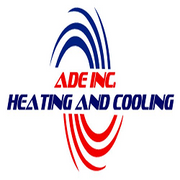Solving uneven home heating.... Click here to learn more!

When it comes to residential heating and cooling, some problems that can arise are more common than others. One of the problems you’re more likely to encounter at some point in your heater’s lifespan is a problem with uneven heating, or uneven temperatures in the house. This usually takes the form of either an upstairs that’s too cold when the heater is providing plenty of heat to the first floor, or certain rooms in the house that aren’t getting as much heat as the others due to their location and size. Now in the beginning of January we’re truly feeling the full effects of the winter weather.
Because of that, any issue with your heater is going to be an urgent matter. If you’re experiencing an unsatisfactory comfort level in your home because of an issue involving uneven heat distribution you may be at a loss about what to do. Short of cranking up the heat, wasting energy, and making some of the rooms too warm, there may seem like there’s little you can do to solve this particular issue. That’s why in this tip of the day we’re going to look at some of many methods for tackling this problem of uneven home heating.
Solution #1: Check the Vents
Before you move on to more drastic, time and/or money spending measures to solve the uneven home heating issue you have you’ll want to first check to see if this isn’t an issue with the vents themselves. The air vents in your home are the gateways between the heater and the air of your home. They provide both an outlet for the warm air being produced by the heater and an intake measure for the cool air being displaced.
So make sure they have uninterrupted access to the space in your home. Look around to see if you have any blocked or dirty vents as this can sometimes be a cause of uneven heating. Your vents and your registers can contribute to uneven heating if they’re blocked by furniture or anything else. This can also happen if dust and debris builds up on them. You can vacuum them with a vacuum with an attachment to loosen and remove the debris.
You can also redirect air to certain areas by partially (but not fully) closing some vents on the first floor. This way, more air will redirect to the second floor and beyond. It is paramount that you don’t actually close the vents all the way though. Just angle the vents so that the air is focused upward. This will help alleviate pressure build up in the system that would be caused if you were to fully close first floor vents.
Solution #2: Investigate Your Air Filter and Thermostat
Before we move on to the solutions to this problem that will involve the help of professionals, let’s take a look at two of the last potential solutions that might have been overlooked. These are both easy fixes if they do in fact solve the problem so it is worth mentioning these before moving on to the more robust measures.
The first thing is to just check the thermostat to make sure the settings are all in order. You’d be surprised at how often an issue with your heating and cooling is just due to the thermostat settings somehow coming undone. So check to make sure the thermostat is set to Auto and not On and that it is set to Heat. Make sure the temperature is set above what the ambient temperature is and make sure air is flowing out of all the vents in the house. If your thermostat fan is already on
Auto, try switching it to On as a quick fix. This tells the fan to run continuously and can help circulate air more consistently throughout the house.
The other thing to knock off your list before moving on and calling a technician is the air filters. When an air filter is dirty, it’s less likely that the air will get through and into the rooms where you need it. If you ensure that you change your air filters on a regular basis, you’ll likely avoid the problem of bad circulation due to dirt. The air filters are a vital part of the air circulation in your home. Bad circulation means a high chance of uneven heating.
Solution #3: Have the Ductwork Inspected
The next step in the troubleshooting of an uneven heating problem is going to be a ductwork inspection. The ductwork is like the circulatory system of your house. It is the means through which warm air is distributed in the winter. If there is a problem with the ductwork this can easily lead to uneven heating as certain air vents are going to get more air than others. This could be due to anything from a buildup of debris deep inside the vents to some kind of leak or just bad design.
Improperly sized and leaky ducts are often the culprits of uneven heating. Ultimately, homeowners with temperature variance issues should consult a reputable heating and cooling contractor to diagnose the issue and determine possible solutions and checking the ductwork is often going to be the first step. Doing so could not only make their home feel more comfortable, it can help ensure they are using their heating and cooling energy as efficiently as possible.
Ductwork that is leaking, crushed or disconnected will not deliver the intended amount of air flow. Something like an unseen disconnected supply duct in the attic will obviously not be delivering any conditioned air to the room it was intended for. The result will be an uncomfortable room and a higher utility bill. Alternatively there are instances in which the duct system is airtight,
but the airflow is still restrictive. If the ducts are kinked, crushed or restricted there will most likely be uneven temperatures in the home. Not to mention you could have an air leak anywhere in your ductwork and this will also cause an imbalance in the circulation of air, ultimately leading to uneven temperatures and uncomfortable rooms.
All of these issues and more will come standard with any professional ductwork inspection from a reputable heating and cooling contractor like ADE Heating and Cooling Inc.
Solution #4: Zoned System
Sometimes the underlying issue when you encounter uneven heating and cooling is more systemic than just a dirty air filter or a leaky vent. Especially if you have a particularly large house, sometimes the issue is more with the design and the size of the system itself and can’t be fixed without alternative measures. One of those measures that can be extremely effective and is specifically designed to tackle this problem is a zoning system.
If your only thermostat is located on the first floor, the temperature that it reads will govern. When the first floor reaches your target temperature, it shuts off cooling or heating for the whole house, regardless of whether the second floor has also reached that temperature. Zoning systems allow you to control the temperature independently from a thermostat placed on each floor. It's a less-expensive alternative if you've got a powerful heating and cooling system that just isn't working to its full potential.
This can even solve an issue with a specific room that isn’t getting as much heat as the others, as is often the case with a large bonus room above the garage for example. A thermostat for each zone means that you can control the electronic dampers in your air ducts. These dampers control the flow of warm or cool air throughout your home, operating similarly to valves.
Furthermore, because heat rises, upper levels are more commonly warmer than lower levels which can especially be an issue with our hot summers. With a zoned system, as one zone reaches the required temperature, the thermostat slows the flow of air to that zone. This, in turn, sends more air to other zones and the end result is an even spread of temperature throughout your home, eliminating those annoying hot and cold spots.
A final benefit of a zoned system is to cater to the different comfort levels for many people living in one house. Fighting over the temperature control of your thermostat is commonplace, and this can be remedied by creating a heating/cooling zone not just on a different level, but even in a particular room. There are many configurations a professional HVAC contractor can use to set up customized zones in your home. The number of zones recommended will depend on your current heating and cooling situation and the type, size and layout of your home. In general, a zoned system is probably the best option for those that want absolute control over the temperatures in their household when just one thermostat and one temperature control isn’t cutting it.
Solution #5: Add a Ductless Mini Split
This solution will be particularly effective in situations where it’s just one or two rooms in your house that for whatever reason aren’t getting as much warm air as the rest. Essentially an air conditioner or heater without the ductwork, these small room-based units pass warm or cool air through small air handlers mounted on the wall. The homeowner can control the temperature independently in each room the air handler is installed. These devices will give you total control over a specific area in your house, making them the perfect solution for uneven temperatures that are limited to one or two problem areas in your home.
As the weather has reached full blown winter status it is more important than ever that your HVAC system is in the best shape possible. One potential issue you may be struggling with is uneven temperatures throughout your house. Hopefully with the help of these tips you’ll be armed with some knowledge of how to tackle such an issue so you can remain warm and comfortable throughout the winter.
If you have any sort of issue with your heater, not just uneven temperature related, you can rely on ADE Heating and Cooling Inc. to set it straight!
ADE Heating and Cooling Inc.
609-693-6050
NJ Master HVACR Lic # 19HC00400200
NJ Master HVACR Lic # 19HC00136200
NJ Master Plumbing Lic # 36B10068500
About the Business
Have a question? Ask the experts!
Send your question

